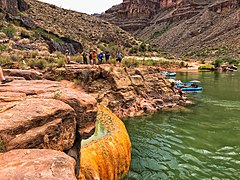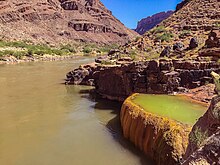| Pumpkin Spring | |
|---|---|
 Pumpkin Hot Spring (source at left of image) Pumpkin Hot Spring (source at left of image) | |
| Location | Grand Canyon |
| Coordinates | 35°54′58″N 113°20′03″W / 35.91618°N 113.33415°W / 35.91618; -113.33415 |
| Elevation | 480 feet |
| Discharge | 200 mL/s |
| Temperature | 23 °C |

Pumpkin Spring is a geothermal heated mineral water hot spring located in the Grand Canyon in Arizona.
The spring gets its name due to the bright orange mineral and organic deposits that have accumulated on the flowstone, giving it the appearance of a huge pumpkin. At the surface, the spring morphology is a mineralized carbonate mound-form.
The spring water flows from within the pool which is surrounded by a travertine that has formed around the source. The water flows over the left bank lip of the mound down to the river at the upstream end of pool into the downstream side of the river.
Water profile
The hot spring water that emerges from a mineralized carbonate mound has a mineral content that includes high levels of arsenic (1100 mg per 1 liter of water), as well as zinc, lead, and copper. The temperature of the water emerges at 23 °C, at a rate of 200 milliliters per second, and has a Ph of 7.0.
The hot spring and associated collection pool contains some of the most poisonous water in the Grand Canyon. Soaking in this hot spring water is discouraged; it is prohibited to drink from this spring due to the level of arsenic.
Location
The spring is located at the bottom of the Grand Canyon near the shore of the Colorado River near mile 212.9.
See also
References
- ^ "Pumpkin Spring Pool Littlefield, Arizona". Atlas Obscura. Retrieved 4 August 2020.
- "10 Spring Types Are Found in Grand Canyon". U.S. National Park System. Retrieved 4 August 2020.
- Felmlee, J. Karen; Cadigan, Robert A. "Radioactivity and geochemistry of selected mineral-spring waters in the Western United States Basic data and multivariate statistical analysis" (PDF). U.S. Department of the Interior. Retrieved 4 August 2020.
- Taylor, Howard E.; Spence, John R.; Antweiler, Ronald C.; Berghoff, Kevin; Plowman, Terry I.; Peart, Dale B.; Roth, David A. (2004). Water Quality and Quantity of Selected Springs and Seeps Along the Colorado River Corridor, Utah and Arizona: Arches National Park, Canyonlands National Park, Glen Canyon National Recreation Area, and Grand Canyon National Park, 1997–98. Reston, VA: U.S. Department of the Interior U.S. Geological Survey.
- Monroe, Lee. "There's A Beautiful But Toxic Spring Hiding Right Here In Arizona". Only in Your State. Retrieved 4 August 2020.